-
收藏模板
- 模板信息
- 更新时间:2023-09-22
- 字数:约41639字
- 页数:约26页
- 格式:.doc
- 推荐版本:Office2016及以上版本
- 售价:5 金币
您可能喜欢的文档
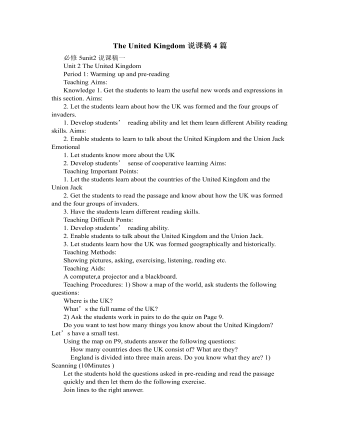
人教版高中英语必修5The United Kingdom说课稿4篇
Teaching Aims:Knowledge 1. Get the students to learn the useful new words and expressions in this section. Aims:2. Let the students learn about how the UK was formed and the four groups of invaders.1. Develop students’ reading ability and let them learn different Ability reading skills. Aims:2. Enable students to learn to talk about the United Kingdom and the Union Jack Emotional 1. Let students know more about the UK2. Develop students’ sense of cooperative learning Aims:Teaching Important Points:1. Let the students learn about the countries of the United Kingdom and the Union Jack2. Get the students to read the passage and know about how the UK was formed and the four groups of invaders.3. Have the students learn different reading skills.Teaching Difficult Ponts:1. Develop students’ reading ability.2. Enable students to talk about the United Kingdom and the Union Jack.3. Let students learn how the UK was formed geographically and historically.Teaching Methods:Showing pictures, asking, exercising, listening, reading etc.Teaching Aids:A computer,a projector and a blackboard.Teaching Procedures: 1) Show a map of the world, ask students the following questions:Where is the UK?What’s the full name of the UK?2) Ask the students work in pairs to do the quiz on Page 9.Do you want to test how many things you know about the United Kingdom? Let’s have a small test.Using the map on P9, students answer the following questions:?How many countries does the UK consist of? What are they??England is divided into three main areas. Do you know what they are? 1) Scanning (10Minutes )Let the students hold the questions asked in pre-reading and read the passagequickly and then let them do the following exercise.Join lines to the right answer.
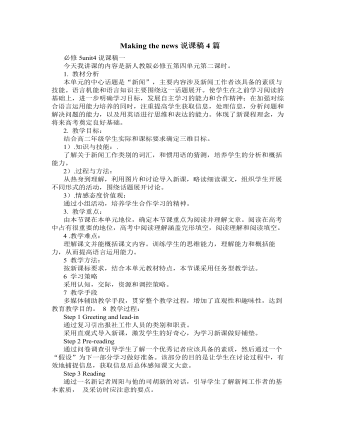
人教版高中英语必修5Making the news说课稿4篇
今天我们来介绍一下必修五第四单元的授课方式。这个单元的题目是Making the news。应该是学生比较感兴趣的话题,学生往往对新闻工作充满好奇,所以我们可以利用这个机会多设计一些师生互动和学生互动,来激发起学习的积极性,提高学习效率。同时我们可以利用这个单元不仅帮助学生掌握语言知识,培养语言能力,同时让其了解新闻工作的重要性,培养起社会智能感。这个单元分为六个课时,它的教学目标是这样的:语言目标是掌握词汇表中的常用单词和短语,掌握倒装句的一些基本用法。 技能目标是能初步掌握约会的基本句型并在真实的场景下正确运用。新闻报道类文章的写作技能。采访的基本规范和沟通技能。情感目标是对新闻报道的客观性和真实性有更好的理解。对新闻记者的职业有更深入的了解,并能体会其工作的重要性。下面我们来介绍一下第一课时的授课方式,第一课的教学目标是这样的第一课时的教学目标语言目标:单词:Occupation, journalist, editor, photographer, curious, personality, enthusiasm

人教版高中英语必修3Astronomy the science of the stars说课稿3篇
Step 2 Pre-listeningAfter students finish their discussion, I will show a picture of Newton and ask them: Who is him? What is he famous for? Could you find out some words to describe him? Maybe students will answer that he is genius for his finding of theGravitation, making a great contribution to the progress of human being. At that time I will show another two pictures of Einstein and Hawking, letting students guess who they are and write down their idea about the Gravitation. For I have arranged them to search more information about the gravity before this class, Students have beenfamiliar with the topic and will not be afraid about this abstract conception, which is helpful for their listening.Step 3 While-listeningIn this step, students will be required to listen the material for three times. The first and listening is extensive listening and the second and third listening is intensive listening. In the first time, They are required to listen a material including Part 1 and Part 2 and choose the best summary of the listening text. After they choose the right answer, They also need work in group to explain what is wrong with the others. Then I will make a conclusion that we should pay attention to the first paragraph and last paragraph and some keys to get the main idea. By doing this, their capacity of generalization will have a great improvement.Before the second listening, I will ask students to scan the blank on the power point quickly and ask them to note down some key words .Then ask them to listen to the Part 1again and fill the first column of the chart. Maybe some students just show the ideas of these three scientists an still can’t catch their development of gravity. Therefore, I will ask them to listen to Part 2 again and fill in the rest. After finish the listening, I will give them ten minutes to discuss with their partner. I will also guidethem to improve their answers when they discuss with others.
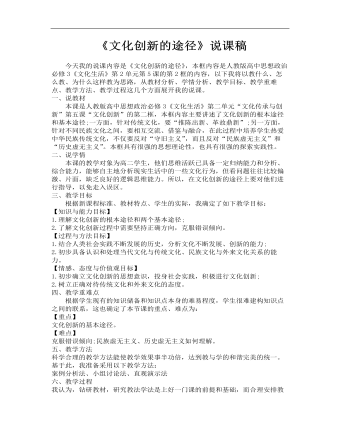
高中思想政治人教版必修三《文化创新的途径》说课稿
二、说学情本课的教学对象为高二学生,他们思维活跃已具备一定归纳能力和分析、综合能力,能够自主地分析现实生活中的一些文化行为,但看问题往往比较偏激、片面,缺乏良好的逻辑思维能力。所以,在文化创新的途径上要对他们进行指导,以免走入误区。三、教学目标根据新课程标准、教材特点、学生的实际,我确定了如下教学目标:【知识与能力目标】1.理解文化创新的根本途径和两个基本途径;2.了解文化创新过程中需要坚持正确方向,克服错误倾向。
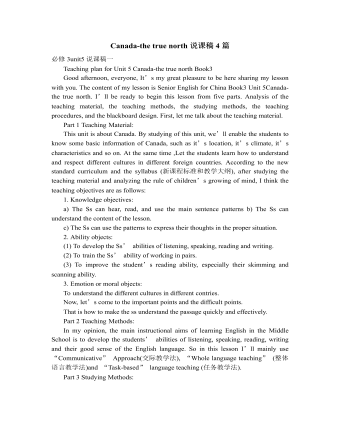
人教版高中英语必修3Canada-the true north说课稿4篇
Good afternoon, teachers, It’s my great pleasure to be here sharing my lesson with you.The content of my lesson is Senior English Book 3 Unit 5 Canada —— “The true North”.I’ll be ready to begin this lesson from five parts. Analysis of the teaching material,the teaching methods,the studying methods, the teaching procedure,and Blackboard design.First, let me talk about the teaching material.Part 1 Teaching Material:This unit is about the introduction of Canada. By studying of this unit,we’ll enable the students to learn the geography, population, main cities, and natural beauty, natural resources of Canada. Through the training of the unit, it also requires students to learn some Language skills such as the expressions of position and emotions.So it plays an important part in the English teaching in this book.After studying the teaching material and analyzing the rule of children’s growing of mind,I think the teaching aims are the followings:1.Knowledge objects:(1) make the students learn some new words and phrases(2) make the students understand the content of the lesson.2.Ability objects:(1)To develop the Ss’ abilities of listening, speaking, reading and writing. Especially reading and speaking ability.(2) learn to talk about the characters of Canada in English(3)To train the Ss’ ability of working in pairs.3.Emotion objects:(1)Enable students to understand the characters of Canada..(2)Stimulate Ss to work hard to make China stronger.Part 2 Teaching Methods:I think helping students learn to master new words and phrases and improve the students’ reading and speaking ability is import and the difficult.According to the analysis of the teaching material and the import points and the difficult points,I will use the following teaching methods : question-guiding approach; fast-reading and careful reading; multi-media teaching methods; discussion
- 查看更多相关Word文档
Life in the Future说课稿5篇
必修5unit3说课稿一
Good afternoon, everyone. It’s my greatpleasure to be here sharing my lesson with you. The content of my lesson isSenior English for China Book5 Unit 3 Life in the Future. I’ll be ready tobegin this lesson from six parts: Analysis of the teaching material, Analysisof the students, Teaching aims and important and difficult points, Teachingmethods and aids, Teaching procedures, and Blackboard design. First, let me talk about the teachingmaterial.

Part 1 Analysis of the Teaching Material:
This unit is about whathuman beings’ life will be like in about one thousand years. By studying ofthis unit, we’ll Enable the students to know the changes in humans’ life andsome new inventions bringing about the change and develop the interest inscience. This lesson plays an important part in the English teaching in thisunit. This is an important lesson in Book Five. From this lesson, it startsasking the Ss to grasp contents of each passage. Therefore, this lesson is inthe important position of the teaching material. If the Ss can learn it well,it will be helpful to make the Ss learn the rest of this unit.
Part 2 Analysisof the Ss
As Senior2 Ss, they are at differentlevels of English fluency, some of them have lost interest in English. Soduring the lesson, I arrange a variety of activities to let all of them join into attract their interest and let them be confident and taste the joy ofsuccess.
Part 3 TeachingGoals and Important and difficult Points
一. Teaching Goals
1. Knowledge goals
To master the important words andsentences patterns of this unit through this period:constantly, previous,uncertain, guide, surroundings, press, belt, flashed, take up, be back on one’sfeet, sweep up, lose sight of, etc.
2. Ability goals
① Enable the Ss to have the ability toknow and talk about what humans’ life will be like in the year AD 3008;
② Let the Ss learn the reading skills ofskimming, scanning and getting the main idea of each part and each passage
3. Moral goals
Increase the Ss’ interest in English
二.Key teaching points and difficultpoints
1. How tohelp the Ss to talk about the humans’life in the year AD3008;.
2. How toimprove the Ss’ reading abilities;
3. How to grasp the main idea of eachparagraph / part & each passage.
Part 4. Teaching Methods and Aids
Task-based method, brainstorming,skimming, scanning, competition, discussion, role-play, class work, etc.
Multi-media aid , a tape recorder andsome pictures.
Part 5. Teaching procedures
Step1. Warming up & Lead-in
Step2. Fast reading
Step3. Detailed reading
Step4. Discussion
Step5. Role play
Step6. Summary & Homework
Step1. Warming up & Lead-in
1. At first I’ll lead-in thepassage by sharing a short video----“The problems which our world is facing” toattract their interest. Meanwhile, ask them to talk about what problems ourhuman beings are facing today. Then discuss which problems do you think peoplewill have overcome in one thousand years and which problems do you think willstill exist in AD3008 and why?
The pre-reading preparesSs for the passage and relates the subjects of their own experience. They areencouraged to speak out their answer. Different answers are available.
2. A free talk: Do you want toknow what people’s life will be like in one thousand years?
Imagine, there is a time machine, we cantake it to travel to the year AD3008. Do you want to take the travel? Let’s doit.
Step2. Fast Reading
Ask students to read the text fast toget the main idea of the text. Answer the following questions:
Who is going on the trip to the yearAD3008?
What impression is it?
What is the form of this passage? (ane-mail) Who is Li Qiang writing to?
What is the main idea of this passage?
(With the task, students are expectedto grasp the theme of the article.)
Step3. Careful Reading
1. Ask the Ss to finish the following 4Exercises by using competitions. I’ll divide the Ss into 4 groups. If a studentcan answer the questions correctly, then his/ her group can get one point. Andthe group which gets the most points is the winner. Only through co-operationcan the Ss taste the joy of success. If the Ss know their answer is right, he’llbe confident and they’ll surely become more enthusiastic in learning English.The purpose is to the Ss’ reading comprehension.
Task 1:
Task 2: Finish the Exercise 1 on Page 19
Task 3: Finish Ex.2 on Page 19
Task 4: Finish Ex.3 on Page 19
2. Now try to find outwhat happened to Li Qiang before, during and after the journey.
Before the journey | Li felt _______ and ________ at first. As a result ,he suffered from _______. |
During the journey (1) | Li was transported safely into the future in a ___________. |
During the journey(2)
| _________by the new surroundings, Li was hit by the ____ of fresh air and his head ______. |
After the journey (1) | Arriving home, Li was ______ into a large bright, clean room with a _____ wall, a _____ floor and ____ lighting. |
After the journey (2) | _________, he slid into bed and ___ fast ______. |
(The task enables students to have a good knowledge of text.)
Step4. Discussion
Did you doanything bad for the environment in your daily life?
What shouldyou do to make our world more beautiful?
Answers:
1.Using the handkerchief instead of the paper napkin.
2.Using paper bags instead of plasticbags.
3. Don’t use one-off chopsticks.
4. Go to work/school on foot or by bikenot by car.
5. Throw cans, bottles, paper andplastic into the dustbin.
……..
Step5. Role Play
Suppose Li Qiang has come back from theyear AD3008, you are his friends or classmate. What questions will you ask himand what will he answer?
Student A --------Li Qiang’s friend orclassmate
Student B --------Li Qiang
(With the task, students learn to gather the main information.)
Step6. Summary and Homework
Homework: 1. Choose one paragraph to read aloudand retell it.
2. Previewthe reading on Page 22.
Part 6. The Blackboard Design
(略)
必修5unit3说课稿二
Unit 3 Life in the future说课稿
一、说教材
1. 教材内容分析
本单元的中心话题是“谈未来”,内容主要涉及人类对今后生活环境的想象、猜测和思考。语言技能和语言知识主要围绕“未来生活”这一中心话题进行设计。
2. 说教学目标的确立及其依据本节课是以谈论未来生活为主题的口语课,根据本课的内容和要点制定以下的三维目标:
(1) 语言知识目标:学习文章中在“未来世界”的跨时空旅行、交通、住房、环境和空气质量等五个方面的英文描述;学习使用有关预测和猜测的表达方式。
(2) 能力目标:从素质教育的要求和学习语言的目的来看,高中英语教学重视培养学生运用英语进行交际的能力。这堂课重视培养学生的口语表达能力,体现英语教学的交际性、准确性和实践性。因此本节课教学着重培养学生的口语表达能力。
(3) 德育目标:学生在本单元的学习过程和开展的小组讨论活动中,除了增长语言知识、提高用英语交际的意识和能力外,更要拓展对未来生活的想象力;并且从分享“未来生活”的主题活动感受的过程中,加强合作意识、陶冶情操,提高自身素养。
3. 说重点和难点
1) Inspire the students to imagine thefuture life and say something about the future, for example, transportation andhousing, using the proper expressions.
2)Enable the students to understand themeaning of the text, and say something according to the text.
3)To improve the students’ oral ability. Practise two topics:
①What do you suppose the futuretransportation will be like? ②4) Retelling the text.
二.说学生
教学对象是高二(6)班的学生,这个班学生的英语基础整体比较好。
三. 说教法
在具体教学中以情景教学法为主,充分利用直观教具和多媒体手段,配以适当的视频画面,给学生以直观生动的体会,培养学生直接用英语理解、表达和思维的能力。让学生积极参与,充分调动他们的学习积极性,以有限的课堂为载体,带学生进入广泛的知识天地。四. 说学法
本课内容是未来生活环境的想象、猜测和思考,因此在教学过程中指导学生从跨时空旅程、交通、住房、空气和环境等方面谈论,运用相应的词汇,强化记忆、发现学习,培养学生的观察力、记忆力、想象力、思维能力。
五.说教具: 电脑,多媒体教学设备. 六.说教学程序
本课通过 Lead-in 、Skimming 、Q&A、Discussion、Summary 五步骤培养学生的分析和概括能力。
Teaching procedures: Step1: Lead-in .
Enjoy a short video, cut from a sciencefiction film I, robot, to lead the students to imagine the future world. Step2:Fast Reading
Ask the students to read the text quickly,then find out the main idea of the text, and answer several questions accordingto each paragraph.
purpose: These questionts are simplequestions, just to help the students get a brief acquaintance to the futureworld described in the text.
Step3: Listening and retelling accordingto paragraph 4. Show some tips to help the
students retell the sentences.
Purpose: This exercise is a practice fororal test part C in NCEE.
Step4: Design two topics while talking aboutthe hovering carriage and Wang Ping’s
house. Practise the dialogues of makingpredictions.
Topic 1 Topic 2 The students may use thesestructures :
I suppose the transportation will besomething like a ….
I suppose , in the future, the house willbe built in…..I imagine that ….
Purpose: To practise the structure orallyI suppose that…, I imagine that..Step5: Summary of the text orally.
Step6: Discussion.
“What’s the writer’s attitude towards the future, optimisticor pessimistic?”“How doyou know? “
The students may begin like these :
• In my opinion, the writer’s attitude towards the future is _________. • Asfar as I am concerned, the writer feels _________ to the future. • I think the writer has an _________ viewof the future.
Purpose: To learn to analyze the writer’s attitude and express your conclusion.Step7 Homework
1. To talk with your chair mate on thetopic: Imagine, what the future world will be? 2. Review the reading passageand find out the difficult language points to you. 3. Finish exercises1,2&4 on page 19.
4. Review the words and phrases of thisunit. A dictation tomorrow.
Unit 3 Life in the Future wh- do yousuppose ….?I suppose …..I imagine that….
And some words, perhaps they will be:science fiction film, high-tech, time tunnel
1. What did Wang Ping’s house look like?
large, bright and clean
His house is a large bright, clean room.
It had a green wall, a brown floor andsoft lighting.
必修5unit3说课稿三
Unit 3 life in the future FirstImpressions
Good morning, professors, it’s my great pleasure to be here sharing mylessons with you. The content of the lesson is New Senior English for ChinaStudent’s Book5 Unit 3 life in the future . I’ll begin the lesson from the following sixparts,
Part 1.Analysis of the teaching material
Part 2.Analysis of the students
Part 3.The teaching methods
Part 4.The studying methods
Part 5.The teaching procedure
Part 6.Blackboard design
Part 1.Analysis of the teaching material
The teaching material includes teachingcontent , teaching aims , teaching key points and teaching difficult points.
Teaching content
This unit is about life in the future ,and the reading passage plays an important part in this unit . It not onlyprovides the chance for the students to learn about what the life may be likein the future ,but also includes many useful words ,expressions and grammarpoints that students should learn in this unit.
Teaching aims
1. Knowledge aims:
(1)To help students to understand the wordsand some useful expressions
(2)To get the students to know about what thelife may be like in the future .
2. Ability aims:
(1) To train the students’ reading ability by fast reading andcareful reading ,and get them to learn more reading skills.
(2) To help the students talk about thelife in about 1000 years in English.
3. Emotional aims:
(1) To increase the students’ interest in science and develop theirimagination.
(2)To call up the students to protect theenvironment.
Teaching key points
1. To train the students’ reading ability
2. To help the students talk about thelife in about 1000 years in English.
Teaching difficult points
1. To develop the students’ reading ability
2. To help the students grasp the mainidea of each paragraph and the whole passage Part 2.Analysis of the students
On the one hand ,they’ve learnt English for years, the studentshave got the basic abilities of listening, speaking, reading, and writing, theystill need many opportunities to practice what they have learned, to expresstheir ideas, feelings, and experiences and to develop their self-dependentlearning ability and cooperative learning ability
Part 3.The teaching methods
a. Task-based Language Teaching
b. Discussion
c. Question-and-answer Method
d. Role-play
Part 4.The studying methods
a. self-dependent learning method
b. Cooperative learning method
Part 5.The teaching procedure
Step 1 Lead-in
I will lead in the lesson of the unit byshowing pictures about the life in the past ,today and in the future ,and talkabout them .
Purpose: To increase the students’ interest, attract their attention andlead in step 2. Step 2 Fast reading
3. Ask them to choose the main idea ofeach paragraph
Paragraph 1( ) Paragraph 2 ( )Paragraph 3()Paragraph 4( )
A. How I came to take a time traveljourney
B. Staying Wang Ping’s home
C. The journey
D. My impressions of the life one thousandyears into the future
Methods: self-dependent learning method ,Question-and-answer Method, task-based language teaching
Purpose :To train the students’ self-dependent learning ability and havea brief understanding of the passage.
Step 3. Careful Reading
1.Get the students to read the passagecarefully ,and then finish Exercise 1 and Exercise 2 on page 19
I’ll divide the students into 4 groups ,andthen ask them to finish the tasks by competition and cooperation.If anyoneanswers the question correctly,his or her group will get 1 point,and the groupwhich get the most points is the winner.
Methods :cooperative learning method ,competition, task-based language teaching
Purpose :To train the students to graspthe detailed information and have a better understanding of the text.Throughcooperation and competitions,the students get the joy of success which makesthe students become more interesed in learning English, at the same time ,itcan help the students improve the cooperative learning ability.
Step 4 Activity
Ask the students to work in pairs ,oneacts as Li Qiang ,the other acts as a reporter that wants to interview Li Qiang.
Methods: cooperative learning method ,role-play , task-based language teaching
Purpose :To train the students’ speaking and thinking abilities andimpove their abilitiy of communicating in English.role-play teaching method canarouse the interest of learning and make the students learn better.
Step 5. Summary and homework
1.Get the students to retell the text withthe help of the information on the blackboard.
2.Imagine you are studying in a school inabout 1000 years ,what may it be like ?Please write a composition about it .
Purpose: By doing this , the students canreview the knowledge they have learnt in this lesson and train their writingability.
Part 6.Blackboard design
First impressions
1. What is the main idea of the passage ?
2 Choose the main idea of each paragraph
Paragraph 1( ) Paragraph 2 ( )Paragraph 3()Paragraph 4( )
A.How I came to take a time travel journey
B.Staying Wang Ping’s home
C.The journey
D.My impressions of the life one thousandyears into the future
The purpose of this part is to get thestudents to have a clear idea to get the main content of this lesson.
必修5unit3说课稿四
Book5Unit3 Life in the Future说课稿
The content of my lesson is Senior Englishfor China Book5 Unit 3 Life in the Future. I’ll be ready to begin this lesson from sixparts: Analysis of the teaching material, Analysis of the students, Teachingaims and important and difficult points, Teaching methods and aids, Teachingprocedures, and Blackboard design. First, let me talk about the teachingmaterial.
Part 1 Analysis of the Teaching Material:
This unit is about what human beings’ life will be like in about one thousandyears. By studying of this unit, we’ll Enable the students to know the changesin humans’life and some new inventions bringing about the change and develop the interestin science. This lesson plays an important part in the English teaching in thisunit. This is an important lesson in Book Five. From this lesson, it startsasking the Ss to grasp contents of each passage. Therefore, this lesson is inthe important position of the teaching material. If the Ss can learn it well,it will be helpful to make the Ss learn the rest of this unit.
Part 2 Analysis of the Ss
As Senior2 Ss, they are at differentlevels of English fluency, some of them have lost interest in English. Soduring the lesson, I arrange a variety of activities to let all of them join into attract their interest and let them be confident and taste the joy ofsuccess.
Part 3 Teaching Goals and Important anddifficult Points
一. Teaching Goals
1. Knowledge goals
To master the important words andsentences patterns of this unit through this period:constantly, previous,uncertain, guide, surroundings, press, belt, flashed, take up, be back on one’s feet, sweep up, lose sight of, etc.
2. Ability goals
① Enable the Ss to have the ability to knowand talk about what humans’ life will be like in the year AD 3008;
② Let the Ss learn the reading skills ofskimming, scanning and getting the main idea of each part and each passage
3. Moral goals
Increase the Ss’ interest in English
二.Key teaching points and difficult points
1. How to help the Ss to talk about thehumans’ lifein the year AD3008;.
2. How to improve the Ss’ reading abilities;
3. How to grasp the main idea of eachparagraph / part & each passage.
Part 4. Teaching Methods and Aids
Task-based method, brainstorming,skimming, scanning, competition, discussion, role-play, class work, etc.
Multi-media aid , a tape recorder and somepictures.
Part 5. Teaching procedures
Step1. Warming up & Lead-in
Step2. Fast reading
Step3. Detailed reading
Step4. Discussion
Step5. Role play
Step6. Summary & Homework
Step1. Warming up & Lead-in
1. At first I’ll lead-in the passage by sharing a shortvideo----“Theproblems which our world is
facing” to attract their interest. Meanwhile, askthem to talk about what problems our human beings are facing today. Thendiscuss which problems do you think people will have overcome in one thousandyears and which problems do you think will still exist in AD3008 and why? Thepre-reading prepares Ss for the passage and relates the subjects of their ownexperience. They are encouraged to speak out their answer. Different answersare available.
2. A free talk: Do you want to know whatpeople’s lifewill be like in one thousand years?
Imagine, there is a time machine, we cantake it to travel to the year AD3008. Do
you want to take the travel? Let’s do it.
Step2. Fast Reading
Ask students to read the text fast to getthe main idea of the text. Answer the following questions:
Who is going on the trip to the yearAD3008?
What impression is it?
What is the form of this passage? (ane-mail) Who is Li Qiang writing to?
What is the main idea of this passage?(With the task, students are expected to grasp the theme of the article.)
Step3. Careful Reading
1. Ask the Ss to finish the following 4Exercises by using competitions. I’ll divide the Ss into 4 groups. If astudent can answer the questions correctly, then his/ her group can get onepoint. And the group which gets the most points is the winner. Only throughco-operation can the Ss taste the joy of success. If the Ss know their answeris right, he’llbe confident and they’llsurely become more enthusiastic in learning English. The purpose is to the Ss’ reading comprehension.
Task 1: Finish the Exercise 1 on Page 19
Task 2: Finish Ex.2 on Page 19
Task 3: Finish Ex.3 on Page 19
Step4. Discussion
Did you do anything bad for theenvironment in your daily life?
What should you do to make our world morebeautiful ?
Answers:
1.Using 2.Using paper bags instead ofplastic bags.
3. Don’t use one-off chopsticks.
4. Go to work/school on foot or by bikenot by car.
5. Throw cans, bottles, paper and plasticinto the dustbin.
Step5. Role Play
Suppose Li Qiang has come back from theyear AD3008, you are his friends or classmate. What questions will you ask himand what will he answer?
Student A --------Li Qiang’s friend or classmate
Student B --------Li Qiang
(With the task, students learn to gatherthe main information.)
Step6. Homework:
1. Choose one paragraph to read aloud andretell it.
2. Preview the reading on Page 22.
必修5unit3说课稿五
【设计理念】
本教学设计在新课程教学理念的指导下,力求在培养学生的语言知识、知识技能、情感态度、学习策略和文化意识等素养的基础上发展学生综合运用语言的能力,使学生通过观察、体验、探究等主动学习的方法优化英语学习方法,充分发挥自己的学习潜能,形成有效的学习策略。
1. 开展学生活动,发挥主体作用
新课程强调要充分发挥学生在教学过程中的主体作用。本课设计遵循以学生为主体,教师为主导这一教学原则,创设角色扮演情景、激烈讨论提出建议,让学生最大限度地参与教学过程,尊重学生的主体地位,充分发挥学生在学习过程中的主动性、积极性、创造性,使课堂充满活力。
2. 实施情景教学,统合三维目标
本课设计从教学需要出发,创设情景,进行情景设问、讨论,激起学生的情感体验,激活学生思维,帮助学生迅速、正确地理解和接受知识,并在学习过程中培养其积极进取的科学的人生观及价值观,较好地落实了三维目标。而三维目标是相辅相成、相互渗透的,所以在情景教学的过程中,知识的落实、能力的培养、情感态度价值观的渗透交融在一起,实现了三维目标的和谐与统一。
3. 转变学习方式,增强教学效果
新课程要求提倡自主、合作、探究的学习方式,发挥学生的主体性、能动性和独立性,本课设计通过自学课本,小组讨论,综合分析,角色扮演等活动,为学生自主学习、合作学习、探究学习提供了空间,使学生体验了自主之乐,合作之趣,探究之悦,促进了学生知识的构建与运用,能力的培养和提高,情感体验和态度、价值观的形成,增强了教学效果。
4. 运用问题教学,启发学生思维
本课设计按照诱思探究理论要求,遵循学生的认知规律,引导学生去发现问题、分析问题和解决问题,从而掌握知识,形成能力,培养品质。通过对文章分析的由浅入深,由易到难,循序渐进,引导学生结合历史现状和教材信息,发挥想象,活化语言,从而达到综合运用英语进行交际的目的。有利于培养学生的思维能力,激发学生的创新精神。
本教学设计贯穿了新的教学理念,体现了课程改革的鲜明特色,在教学内容的重新调整、教材的合理处理、教学思路的设计等方面作了尝试性的突破与创新,具有较强的实践性和操作性。
【教材分析】
本单元教学内容为人教版新课标Module 5 Unit 3 Life in the future。本单元的中心话题是“未来生活”,教材内容为学生提供了想象的空间,旨在培养学生预测未来的能力,通过对现实生活与未来生活的对比,唤醒学生把握现在,珍惜现在,爱护环境,保护自然的意识。
第一篇Reading文章主要讲述主人公Li Qiang在时空旅行前、时空旅行中及时空旅行后的所见所想。第二篇则主要记叙了Li Qiang在太空站认识的两个非常特别的太空生物,并将两个生物的特征进行了对比。两篇阅读文章都是科幻型阅读,旨在唤起学生的想象力,培养学生对未来生活的预测。语法部分则延续了课文内容,通过作者对未来生活态度的讨论引出过去分词做状语及定语的用法,并以短文填空的形式来巩固文章生词的用法。听力部分则描绘了一个拥有高新科技的wonderland,表明了人类对美好生活的追求与幻想,并最终通过口语情景设置锻炼学生综合运用英语的能力与技巧,从而对未来生活进行更细致的预测。
考虑到各部分内容的内在联系,笔者结合教学实际将同一话题不同内容与形式的材料进行了重组,对教材内容、编排顺序等进行了调整、删减和补充,将整个单元设计成四个课时,丰富了教学内容和语言活动形式。
【学情分析】
1. 认知基础:高一学生基本上能用英语清晰地表达个人观点,准确地描绘
生活现象或表达个人情感,能用基本的词汇、句型对未来生活作出描绘与预测。
2. 心理特征:高中学生思想活跃,求知欲旺盛,学习态度明确,自我意识
发展迅速并趋向成熟,独立自主性强,有一定的道德修养及正确的价值观与审美观。
3. 学习能力:学生对过去分词的用法有基本的了解,其自主阅读与表达能力有一定的基础,具备良好的团体协作能力,并能进行有效成功的交流合作讨论。
【教学目标】
(1)知识与能力
学习与未来生活有关的词汇;能对本单元的生词猜测词义并能用英语释义基本单词;学习有关预测和猜测的表达方式以及过去分词作定语、状语的用法;能听懂关于对未来生活、环境的想象、猜测和思考的会话,想象未来生活可能存在的问题;能用英语简单地谈论未来生活,猜测未来的科技发展趋势;能阅读关于未来生活、未来世界以及外太空和外星人的英语文章;能够较好地发挥想象来描写未来生活和外星生物。
(2)过程与方法
通过网络或图书馆等途径查找搜集有关科学家对未来生活预测的资料,培养学生利用学习资源的策略;并且笔者结合教学实际对教材内容、编排顺序等进行了调整、删减和补充,将整个单元设计成四个课时。第一课时为Warming-up and Reading, 第二课时为Learning about language, 第三课时为Using language, 第四课时为Listening and speaking。着重培养学生学习运用词汇学习中的猜词策略,激发学生想象力,预测未来生活。
(3)情感态度与价值观
通过学习课文,使学生回顾历史,认识现在,展望未来,激发学生的想象力;提高环境保护,资源保护意识。通过讨论使学生了解中国和其他国家目前存在的社会问题以及科技发展方向,预测世界未来生活、环境的发展趋势。
【重点难点】
重点:
1.掌握有关描绘未来生活的词汇以及有关预测和猜测的表达方式。
2.通过对文章的学习,根据目前的现状预测未来的生活,提高环境保护、资源保护意识。
难点:
1.掌握过去分词作定语和状语的用法。
2.运用所学的词汇及句型写出具有一定想象力的短文。
【教学策略与手段】
1.采取多种教学方式,讲述法与讨论法相结合,启发式教学法与创设课堂思维情景相结合,接受式学习与探究式学习相结合。
2.以活动构建教学理论为指导,挖掘课程资源,利用图片、表格、多媒体等多种形式,师生互动,分组探究。
3.适时对学生的学习过程进行调控与激发,实现教学预设与动态生成的统一。
【教学准备】
1.教师整理课堂相关文字、图表、影音资料,制成多媒体课件。
2.课前组织学生搜集、阅读有关世界环境问题、当今科学技术发展及对未来生活预测的文章,积累一定的知识储备。
3.课前按教室座位情况将学生分成若干小组,每组6人,并选出组长一人,以小组为单位开展合作学习。
【教学过程】
Period1: Warming-up & Reading
Teaching Aims:
1. Learn some new words and expressions.
2. Improve the students’ reading skills.
3. Know the more advanced forms oftransport in AD 3005 and the advantages and problems of life in the future.
TeachingMethods:
1. Inductive method
2. Pair work & group work
3. Competition
4. Illustration
5. Deductive Method
Step 1 Greetings and Lead-in
1.The teacher can start with daily greetings and try to lead insome words in this unit.
Q1: Where do you come from? Do you livein the downtown or in the countryside?
Do you live in a comfortable surrounding?
Is it a suitable location for people tolive in?
What is it made of? (brick, stone,steel, glass, wood, plastic, bamboo, mud…).
2.Q2: No matter where you live, I am wondering how do you usuallygo to school? (by bike, by car, by bus…)
Bikes, cars, buses and so on can beused to carry people or things from one place to another place, and they arecalled vehicles. What other vehicles do you know?
carriage, ambulance, jeep, airbus,train, truck, motorcycle, fire engine, …
3.Now let’s take a look at the screen to learn about thedevelopment of all the means of transportation.
sedan chair – carriage – bicycle – motorcycle – car – train –aeroplane – space craft
4.Q3: What will the future means of transportation be like? (Timetravel)
Well, today we are going to learn atext about time travel.
【设计说明】
由日常问候开启话题,通过提问学生家乡情况导入城镇生活,引出不同的建筑材料及交通工具中的生词;然后总结交通工具的发展历史,预测未来的交通方式,引出跨时空旅行,从而进入阅读文章的处理与学习。(由于考虑到Warming-up中的Transport与Houses, Villages,Towns, 以及Location of settlement的联系不大,可单独提出,因此将Transport的发展变化应用于课文的导入中,这样比较科学自然。)
Step 2 Skimming
1.The teacher will ask the students to predict the future life invarious aspects as to inspire their imagination and predicting ability.
Q1:What will the future life be like?
2.The students are given several minutes to read through the textand try to find out the changes mentioned in the text.
Q2: Which changes are mentioned in the text?
time travel – transport – air quality – religion – clothing –eating – houses – towns
3.The teacher can ask the students to carry out a discussionabout the changes.
Q3: Which changes are good and which are bad?
【设计说明】
猜测是培养学生阅读能力的方法之一,因此笔者首先提出问题引发学生思考,对未来生活的各个方面进行预测。其次通过快速阅读的方式,了解文章梗概,把握文章线索,找出文中对未来生活变化的描写,培养学生快速阅读的技巧与能力,并对未来生活变化的好坏进行小组讨论,培养集体协作精神。(由于Comprehending中关于未来生活变化好坏的讨论难度不大,考虑到整个设计的连贯性,将其提至快速阅读中,设置成小讨论,将学生说与读的能力更好地结合。)
Step 3 Reading for details
1.Before the journey
Q1: How many people are mentioned in the text? Who are they?
Q2: When did the writer write this letter? And to which year didhe travel?
Q3: Why did Li Qiang travel to the year AD 3005?
Q4: What did Li Qiang suffer from?
Q5: How did Li Qiang feel? What makes him feel better?
Q6: Where did they arrive?
【设计说明】
通过几个特殊疑问词,提出以下问题,处理文章第一段。因本篇课文是一篇叙事故事,而记叙文时一般都包括事件发生的人物、时间、地点、事件、原因等关键要素,因此让学生通过阅读寻找上述要素,不仅让学生的阅读具有目的性,而且降低了阅读的难度。
2.During the journey
1) In the capsule:
Climb through the round opening -- comfortable seats -- calmingdrink -- lay relaxed -- we rose slowly from the ground -- complete the journey-- 1000 years later -- ?
2) Out of the capsule
Confused by the new surrounding, I was hit by the lack of freshair
Q1: How did Li Qiang overcome the lack of fresh air?
1. Hovering carriage: .
Q2: How did the hovering carriage float?
Q3: How can a person move swiftly?
2. “A large market”
Q4: What were people doing there?
Q5: What happened to Li Qiang?
3. A large building
Q6: What is a “time lag” flashback?
【设计说明】
按事件发生的先后顺序及地点转换顺序,处理文章细节,培养学生抓住文章线索来处理课文的能力。然后根据地点转移,自然地将“太空仓内”转向“太空仓外”,按照作者在太空仓外所处的三个不同地点Hovering carriage, a large market, alarge building来处理文章第三段。
3.After the journey
(Arriving home, he showed me into a large bright, clean room.
Description of the house: brown floor, soft lighting, trees,leaves, computer screen, tables, chairs, green wall…
Q1: How did the author feel after visiting the special house?
Exhausted, I slid into bed and fell fast asleep.
【设计说明】
通过精读课文,了解文章细致内容,按照“时空旅行前,时空旅行中及时空旅行后”的时间线索来处理文章细节。“时空旅行中”又可按照“在太空仓内与在太空仓外”分析文章信息。在此过程中锻炼学生精读的阅读技巧,处理文章生词,并适当地引入几个过去分词做状语及定语的句子,为语法部分的讲解作个铺垫。
Step 4 Consolidation
1.Put the statements into correct order. ( C --- A --- D --- B )
A. We are transported into the future by acomfortable time capsule.
B. I arrived at Wang Ping’s home andeverything in his house made me surprised.
C. I won a travel to the year AD 3005.
D. I have my first try to master ahovering carriage.
2.Discussion: Compare the houses, towns, location of settlementof different period of time and predict about the changes in the future
AD 1005: China ---- AD 2007: Modern World ---- AD______ : Your idea
3.A telephone interview with Li Qiang
Ask the students to discuss in group of six and raise as manyquestions to Li Qiang as possible. Some questions about the problems in futurelife are recommended.
【设计说明】
首先通过对文章故事情节的正常排序回顾文章梗概;其次通过Warming-up中过去、现在的房子、城镇及居住环境的比较来预测未来方的发展与变化;最后设置情景,进行角色扮演,模拟电话采访Li Qiang回顾整篇课文,引出本节课的作业与任务。全面地锻炼学生的总结概括能力以及团体协作的讨论能力。
Step5 Assignment
1.Show some pictures of various kinds of pollution to the studentsto arouse their awareness of environmental protection and then ask the studentswhat have caused those environmental problems in groups.
Q1: What problems are we facing now?
Q2: What have caused those problems?
2.Show some advanced and imaginative inventions to the students,and try to arouse their imagination to design specific objects for a betterfuture life
3.Assignment: Object-designing
Design an object which can help you change the world for a betterfuture
【设计说明】
通过角色扮演以及情景设置中引出未来生活中将会存在的问题,以此导出现在生活中存在的问题,由此自然地引出阅读课的任务----发明设计,以此激发学生的发明创造能力,唤醒学生保护自然、爱护环境的意识,学习中渗透道德教育,一举两得。
Period2: Learning about language
Teaching aims:
1. Learn past participle usedas adverbial.
2. Master some importantwords: swiftly, unsettle, constant, remind, previous, bent, press, link.
Teaching methods:
1. Teach grammar in realsituations.
2. Learn grammar throughpractice.
Step 1 Revision and Preparation
1.Ask the students to talk about the writer’s attitude towardsthe future life, was he optimistic or pessimistic about the future? How do youknow? Can you find some sentences to support your opinion?
2.Ask the students to find out some sentences which can supportthe opinion that the author is pessimistic about the future life.
1 .Confused by the new surroundings, I was hit by the lack offresh air.
2. Worried about the journey, I was unsettled for the first fewdays.
3. Exhausted, I slid into bed and fell fast asleep.
And then ask the students to finish the exercises in theirtextbook.
Ex.1. Combine these two sentences usingthe past participate as the adverbial.
1. I was frightened by the loud noise. Iwent to see what was happening.
Frightened by the loud noise, I went tosee what was happening.
2. He was hit by the lack of fresh air.He got a bad headache.
Hit by the lack of fresh air, he got abad headache.
3.I felt very tired after the longjourney. I still enjoyed meeting the aliens on the space station.
Tired after the long journey, I stillenjoyed meeting the aliens on the space station.
4.Themuseum was built in 1910. The museum is almost 100 years old.
Built in 1910, the museum is almost 100years old.
5. The little girl was frightened bythe noise outside. The little girl dared not sleep in her bedroom.
Frightened by the noise outside, thelittle girl dared not sleep in her bedroom.
6. The student was given some advice bythe famous scientist. The student was not worried about his scientificexperiment any more.
Given some advice by the famousscientist, the student was not worried about his scientific experiment anymore.
3.Ask the students to find out some sentences which can supportthe opinion that the author is optimistic about the future life.
1. His parents company named “Future Tours” transported me safelyinto the future.
2. A table and chairs rose from under the floor as if by magic.
3. Tomorrow you will be ready for some visits organized by thecompany.
And then ask the students to finish the exercises in theirtextbook.
Ex.2. Combine these two sentences usingthe past participate as the attribute.
1. Soon we lost sight of that famousastronomer. He is called Li Qiang.
Soon we lost sight of that famousastronomer called Li Qiang.
2. I am going to buy a painting. It iscopied from Vincent van Gogh.
I am going to buy a painting copiedfrom Vincent van Gogh.
3. The castle is under repair. It was built in 1432
The castle built in 1432 is underrepair.
4. I like that old private house. It isbuilt of wood and mud.
I like that old private house built ofwood and mud.
5. The vehicle is mentioned in thebook. The vehicle is unknown to me.
The vehicle mentioned in the book isunknown to me.
6. The room is completely empty. Theroom is connected to the rest of the house by a long passage.
The room connected to the rest of thehouse by a long passage is completely empty.
7. The queen was sitting in a royalcarriage. The carriage was drawn b four horses.
The queen was sitting in a royalcarriage drawn by four horses.
【设计说明】
通过设置讨论作者对未来生活持乐观还是悲观态度来复习并提升Reading内容,巩固学生对Reading全文线索的了解与掌握,并通过讨论找出含有过去分词用法的句子来支持各自的观点。(由于Reading中Comprehending部分中关于作者对未来生活所持有的态度的讨论跟语法部分联系紧密,故将其从Reading中剪切,转至语法中作为回顾阅读课,导入新课)完成语法练习后,学生对过去分词作状语和定语的用法有了一定的了解,然后教师将过去分词作状语和作定语的用法系统归纳如下:
过去分词作状语可以表示时间、条件、原因、让步、方式或伴随,有时在其前还可以带上连词,以示明确。
1.作时间状语。 Once discovered, the enemies werecompletely wiped out.
2.作原因状语 Moved by his words, I accepted his present.
3.作条件状语 United we stand, divided we fail.
4.作让步状语 Although tired, they continued to work.
5.作方式或伴随状语 The teacher stood there, surrounded bymany students.
注意:
1) 作状语的过去分词通常与句子的主语存在着被动关系,她所表示的动作通常和谓语动词属于同一时间范畴,也可表示先于谓语动词发生的动作。有时为了强调先发生的动作,也可用having been done.
e.g. Having been told many times, he can’t still remember it.
2). 过去分词的逻辑主语要跟主句的主语一致,否则不能用过去分词作状语,应用状语从句。
(误)Checked carefully, some spellingmistakes can be avoided.
(正)If the composition is checkedcarefully, some spelling mistakes can be avoided.
过去分词作定语或状语时,该分词及修饰成分相当一句定语或状语从句,变为定语从句或状语从句中,该从句应该具备两个特征:1)从句的主语和主句中的先行词一致;2)谓语动词为被动语态形式。
Step2 Consolidation
非谓语动词练习
B 1.___ andhappy, Tony stood up and accepted the prize. (2006全国)
A. Surprising B. Surprised C. Being surprised D. To be surprising
A 2.No matter how frequently _______, the works of Beethovenstill attract people all over the world. (2006广东)
A. performed B. performing C. to be performed D. being performed
C 3._________ and I’ll get the workfinished. (2007 重庆)
A. Have one more hour B. One more hour
C. Give one more hour D.If I have one more hour
B. 4. The repairs cost a lot, but its money well _____. (2006 湖北)
A. to spend B. spent C. being spent D. spending
C.5. _____ with a difficult situation, Arnold decided to ask his boss foradvice.(2006江苏)
A. To face B. Having faced C. Faced D. Facing
B 6.When her father, the girl burst into crying. (2005湖北)
A. asking of B. asked about C. being asked D. asked
D 7. The man kept silent in the room unless . (2006浙江)
A. spoken B. speaking C. to speak D. spoken to
D8. ________, the old man is living a happy life. (2006天津)
A. taking good care B. taken good care
C. having taken good care D. taken good care of
D 9.The Olympic Games, in 776B.C., did not include women playersuntil 1912. (NMET2004)
A. first playing B. to be first played
C. to be first playing D. first played
B 10. from his clothes, he is not so poor. (2006上海)
A. Judged B. Judging C. Tojudge D. Having judged
A 11.European football is played in 80 countries, it the most popular sport in the world. (NMET2003)
A. making B. makes C. made D. to make
B 12.The secretary worked late into the night, a long speech for the president. (MET2004)
- to prepare B. preparing C. prepared D. was preparing
C 13. a reply, he decided to write again. (2005北京)
A. Not receiving B. Receiving not
C. Not having received D. Having not received
B 14.The houses are for the old people and the constructionwork will start soon. (2006江苏)
A. built B. tobe built C. to build D. being built
C 15.If ill, I’ll stay home a good rest. (2006辽宁)
A. to fall,taking B. fall; to taking
C. falling; taking D.falling; take
Step 3 Discussion: Life at present V.S. Life in the future
1. Ask the students to carry out adiscussion to compare the present life and life in the future.
Do you want to work for space? Whatworker should be needed for the space?
2. Ask the students whether they wouldlike to work for space if possible, and then ask them to complete thisadvertisement choosing these words in their proper forms.
(constant remind unsettle previous bend press swiftly link)
Many people need to be________of the job opportunities on spacestations, which _________ need space cooks, cleaners, teachers, and computerengineers. You can be _____ trained with one-year space course and then beready to enjoy the benefits of working in space. People are _______ at firstbut soon feel better as families are encouraged to come. For health reasons,only one stay of three years is allowed. So any ______ experience working inspace for this length of time means you cannot apply. Many people ______ tostay longer but the _____ between illness and length of stay on a space stationis too strong. It is sad but the rules cannot be ___ for anyone. 【设计说明】
通过小组讨论让学生展开想象的翅膀,憧憬未来生活的美好,随后通过跟目前生活的比较,教育学生要珍惜现在,展望未来。然后让学生根据自己的实际情况,讨论是否愿意为空间站工作。
转载请注明出处!本文地址:
https://www.lfppt.com/worddetails_2352214.html最新说课稿文档
-
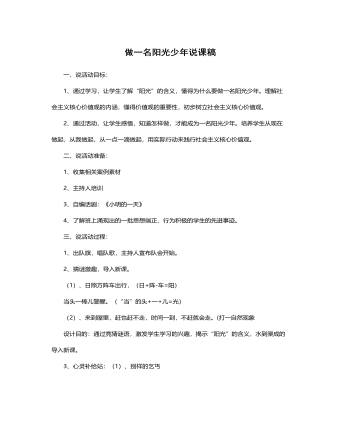
做一名阳光少年说课稿
1、紧密联系学生的生活实际,所选材料、所有活动均本着为主题服务的原则。2、形式多样化。通过心灵补给站、我来当编剧、心动不如行动等丰富多彩的活动,激发学生的热情,充分发挥他们的主体性。3、用生活中的真人真事激励他们,震撼他们的心灵,对学生进行教育,让他们得到感悟。五、说评价方式:要真正发挥主题队会的教育作用,千万不能把主题队会开成“检讨会”、“批评会”。兴趣是最好的老师,在课堂上,学生有了兴趣,才会有学习的动机,所以,在教学过程中,我努力把学生当作一个平等的朋友来对待,对于学生的回答进行评价时,本着“多表扬少批评,多鼓励少指责”的原则,尽量不用指令性、批评性的语言,最大限度的挖掘学生的优点,进行激烈性评价。

追思先烈魂,弘扬爱国情说课稿
环节四深入实践——弘扬爱国情爱国不是一句口号,要将爱国情怀落实到行动中去,队员们在各队队长的组织下,商讨出了落实方案。1、第一小队和第二小队组成了先烈故事演讲团,利用班会十分钟的时间,在三四年级宣讲先烈故事。2、第三小队和第四小队组成了创编小能手,编唱了爱国童谣、爱国拍手歌,告诉大家,爱国无处不在,爱国要从小事做起。3、第五小队和第六小队编写的爱国倡议书,提倡大家让爱国从口号落实到行动。4、全体队员共同宣誓:时刻准备着,为共产主义事业而奋斗,将活动推向了高潮。环节五大队辅导员总结“风雨沧桑,多遭铁蹄践踏,未有沉沦终奋起;荡涤污浊,重聚华夏精魂,披荆斩棘勇向前。”让我们牢记自己是中国人,怀一颗中国心,明确方向,努力奋斗,早日实现自己的梦想。
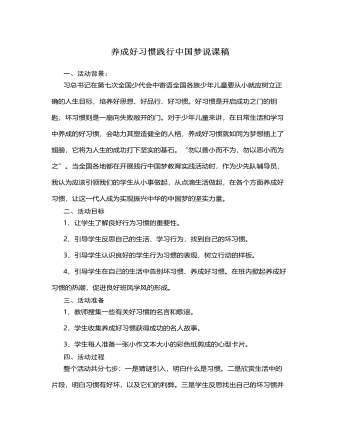
养成好习惯践行中国梦说课稿
第七步:全班学生一起倡读承诺书:(课件出示)我们都是小学生,培养习惯最要紧;上课应当专心听,积极开动小脑筋;作业认真仔细做,按时完成交得勤;有了错误要订正,知识才能学得清;人生要有好习惯,我们牢牢记心上。最后请学生把自己要养成的好习惯写在心意卡上,写好后粘贴在教室后面的园地里,互相督促,使得此次活动教育延续课后,直至影响一生.5、活动效果及反思此次活动开展后,学生们增强了对自身的认识,很多学生下决心改掉自身的坏习惯,并逐步采取了实际行动,从身边的小事做起,而且在学生中间还兴起了互相帮助、互相指正、争相进步的热潮。通过此次活动我也切实的体会到养成教育要开展就要落到实处,从实际出发,让学生亲自去感受,去体会,并且要持之以恒的做下去。同时作为老师更应该有一颗敏感热情的心,随时发现学生身上的闪光点与不足,多指正、多指点、多鼓励、多表扬,做到时时处处皆教育,这样才能赢得孩子,做好教育。
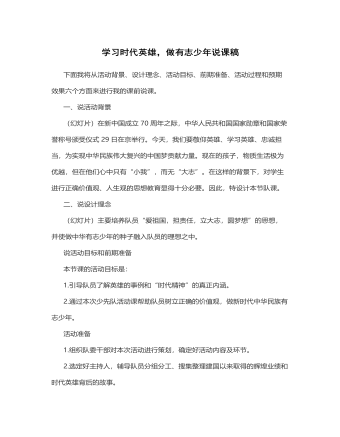
学习时代英雄,做有志少年说课稿
一、说活动背景(幻灯片)在新中国成立70周年之际,中华人民共和国国家勋章和国家荣誉称号颁受仪式29日在京举行。今天,我们要敬仰英雄、学习英雄、忠诚担当,为实现中华民族伟大复兴的中国梦贡献力量。现在的孩子,物质生活极为优越,但在他们心中只有“小我”,而无“大志”。在这样的背景下,对学生进行正确价值观、人生观的思想教育显得十分必要。因此,特设计本节队课。二、说设计理念(幻灯片)主要培养队员“爱祖国,担责任,立大志,圆梦想”的思想,并使做中华有志少年的种子融入队员的理想之中。说活动目标和前期准备本节课的活动目标是:1.引导队员了解英雄的事例和“时代精神”的真正内涵。2.通过本次少先队活动课帮助队员树立正确的价值观,做新时代中华民族有志少年。
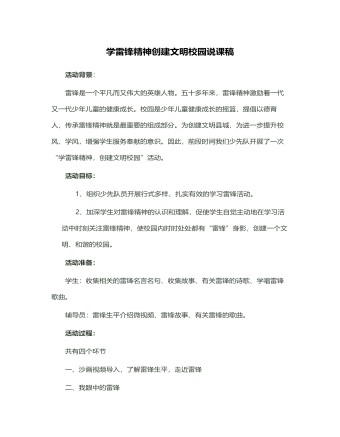
学雷锋精神,创建文明校园说课稿
雷锋精神是什么?这一环节是让学生用简单的词语或句子概括。通过这一活动,让学生概括出雷锋精神的内涵:像无私奉献、乐于助人、为人民服务、勤俭节约、尊老爱幼、勤奋好学、干一行爱一行、言行一致等等都是雷锋精神的体现。我们少年儿童是中国的未来和希望,雷锋精神的发扬和光大,创建文明校园的任务就落在他们的肩上,所以在这里我还设计了为发扬雷锋精神,创建文明校园“我该怎么做”这样的问题,目的就是让他们一起行动起来,学雷锋做好事,并制作了“荣誉”旗,奖励身边的好人好事。活动延伸:这里我设计了一个角色游戏活动——我要义卖献爱心,这个游戏学生们表现得非常积极,他们收集了自己不要的小文具或小玩具,将他们拿到集市上去卖,卖东西获得的钱,捐给王奶奶的孙女,因为王奶奶的孙女生病了,无钱治病。我觉得这个游戏使学生们懂得,一个人只要有爱心,只要愿意去帮助别人,无论什么方式都行,而且在游戏活动中孩子们体会到了帮助别人是一件多么多么快乐的事呀。
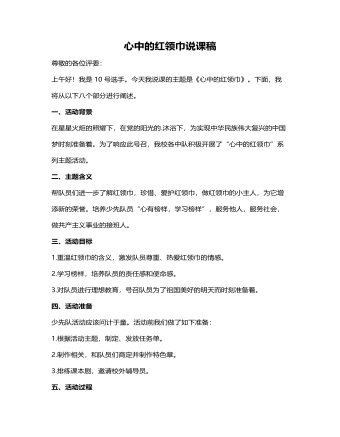
心中的红领巾说课稿
1.学习“最美红领巾”。图文结合,学习“美德少年”刘华婷、刘颖等人的先进事迹。2.记录“平凡红领巾”。展示队员们活动前精心准备的“随手拍”,发现普通队员在日常生活中的闪光点。3.填写“我为红领巾添光彩”心愿卡,对学生进行理想教育。4.齐唱《红领巾之歌》,点燃信念火种。5.辅导员对此次活动进行总结,并颁发特色章。(出示三个特色章图标)六、活动延伸红领巾精神需要代代相传,珍爱红领巾的意识需要时时提醒,本次活动后,我们会开展“小小新四军”、“鲜艳的红领巾”等后续活动,帮助队员们将红领巾精神永远铭记在心。七、引导要点四年级队员具备一定的活动能力和经验,通过课本剧的亲身体验、心愿卡的真情表达等多种方式的运用,引导队员热爱红领巾,以红领巾精神指引自己健康成长。八、活动评价本次活动,队员们受到了良好的教育。但是四年级队员自我约束能力不够强,缺乏持久性,萌生的意识和激情往往只停留在活动时,不能在活动后内化为自觉行为,这些问题有待探究。
今日更新Word
-
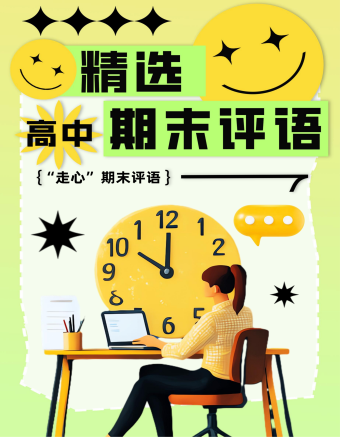
精选高中生期末评语
1、该生学习态度端正 ,能够积极配合老师 ,善于调动课堂气氛。 能够积极完成老师布置的任务。学习劲头足,听课又专注 ,做事更认 真 ,你是同学们学习的榜样。但是,成绩只代表昨天,并不能说明你 明天就一定也很优秀。所以,每个人都应该把成绩当作自己腾飞的起 点。2、 你不爱说话 ,但勤奋好学,诚实可爱;你做事踏实、认真、为 人忠厚 ,是一个品行端正、有上进心、有良好的道德修养的好学生。在学习上,积极、主动,能按时完成老师布置的作业,经过努力 ,各 科成绩都有明显进步,你有较强的思维能力和学习领悟力,学习也有 计划性,但在老师看来,你的潜力还没有完全发挥出来,学习上还要有持久的恒心和顽强的毅力。
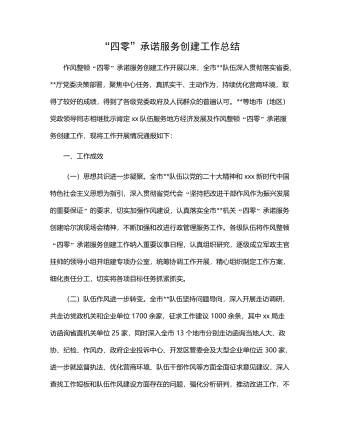
“四零”承诺服务创建工作总结
(二)坚持问题导向,持续改进工作。要继续在提高工作效率和服务质量上下功夫,积极学习借鉴其他部门及xx关于“四零”承诺服务创建工作的先进经验,同时主动查找并着力解决困扰企业和群众办事创业的难点问题。要进一步探索创新,继续优化工作流程,精简审批程序,缩短办事路径,压缩办理时限,深化政务公开,努力为企业当好“保姆”,为群众提供便利,不断适应新时代人民群众对政务服务的新需求。(三)深化内外宣传,树立良好形象。要深入挖掘并及时总结作风整顿“四零”承诺服务创建工作中形成的典型经验做法,进一步强化内部宣传与工作交流,推动全市创建工作质效整体提升。要面向社会和公众庄严承诺并积极践诺,主动接受监督,同时要依托电台、电视台、报纸及微信、微博等各类媒体大力宣传xx队伍作风整顿“四零”承诺服务创建工作成果,不断扩大社会知情面和群众知晓率。
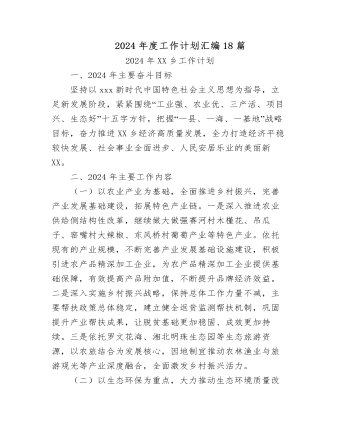
2024年度工作计划汇编(18篇)
1.市政基础设施项目5项,总建设里程2.13km,投资概算2.28亿元。其中,烔炀大道(涉铁)工程施工单位已进场,项目部基本建成,正在办理临时用地、用电及用水等相关工作;中铁佰和佰乐(巢湖)二期10KV外线工程已签订施工合同;黄麓镇健康路、纬四路新建工程均已完成清单初稿编制,亟需黄麓镇完成图审工作和健康路新建工程的前期证件办理;公安学院配套道路项目在黄麓镇完成围墙建设后即可进场施工。2.公益性建设项目6项,总建筑面积15.62万㎡,投资概算10.41亿元。其中,居巢区职业教育中心新建工程、巢湖市世纪新都小学扩建工程已完成施工、监理招标挂网,2月上旬完成全部招标工作;合肥职业技术学院大维修三期已完成招标工作,近期签订施工合同后组织进场施工;半汤疗养院净化和医用气体工程已完成招标工作;半汤疗养院智能化工程因投诉暂时中止;巢湖市中医院(中西医结合医院)新建工程正在按照既定计划推进,预计4月中下旬挂网招标。
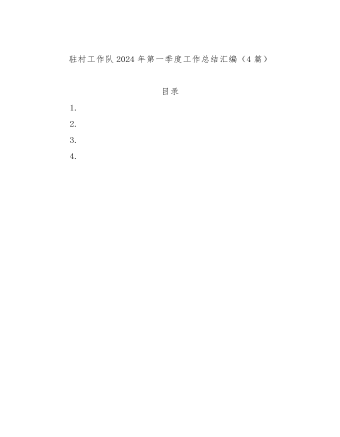
驻村工作队2024年第一季度工作总结汇编(4篇)
三是做大做强海产品自主品牌。工作队于xx年指导成立的冬松村海产品合作社,通过与消费帮扶平台合作,在工作队各派出单位、社会团体、个人支持下,已获得逾xx万元销售额。2022年底工作队推动合作社海产品加工点扩建的工作方案已获批,待资金下拨后将正式启动扩建工作。四是积极助企纾困,带动群众增收致富。工作队利用去年建立的xx镇产业发展工作群,收集本地企业在产品销售、技术、人力、资金、运营、用地等方面的需求,并加大xx支持乡村振兴力度,xx助理赴各村委开展多场xx政策支持乡村振兴宣讲活动,本季度有x万元助农贷款获批,xx万贷款正在审批中。在壮大既有产业的同时,完善联农带农机制,一方面鼓励企业雇用本地农户就业,另一方面计划与本地农户签订长期收购合同,让农民种得放心、种得安心,带动当地群众共同致富。

主题教育总结常用提纲大全
第一,主题教育是一次思想作风的深刻洗礼,初心传统进一步得到回归。第二,主题教育是一次沉疴积弊的集中清扫,突出问题进一步得到整治。第三,主题教育是一次强化为民服务的生动实践,赤子之情进一步得到提振。第四,主题教育是一次激发创业担当的有利契机,发展层次进一步得到提升。2.第一,必须提领思想、武装思想。第二,必须聚焦问题、由表及里。第三,必须领导带头、以上率下。第四,必须务实求实、认真较真。3.一是抬高政治站位,坚持大事大抓。二是坚持思想领先,狠抓学习教育。三是突出问题导向,深入整改纠治。四是坚持领导带头,发挥表率作用。4.一是立足“早”字抓筹划。二是着眼“活”字抓学习。三是围绕“统”字抓协调。5.一是形势所需。二是任务所系。三是职责所在。四是制度所定。6.一要提升认识。二要积极作为。三要密切协作。
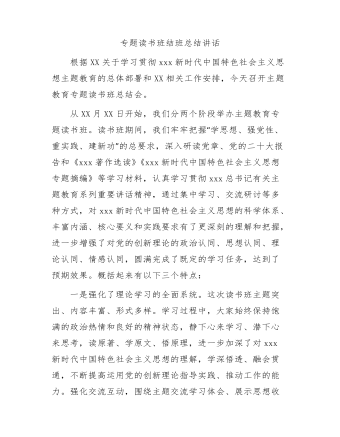
主题教育专题读书班结班总结讲话
第二,要把调查研究贯穿始终,实干担当促进发展。开展好“察实情、出实招”“破难题、促发展”“办实事、解民忧”专项行动,以强化理论学习指导发展实践,以深化调查研究推动解决发展难题。领导班子成员要每人牵头XX个课题开展调查研究,XX月底前召开调研成果交流会,集思广益研究对策措施。各部门、各单位要制定调研计划,通过座谈访谈、问卷调查、统计分析等方式开展调查研究,解决工作实际问题,帮助基层单位和客户解决实际困难。第三,要把检视问题贯穿始终,廉洁奉公树立新风。认真落实公司主题教育整改整治工作方案要求,坚持边学习、边对照、边检视、边整改,对标对表xxx新时代中国特色社会主义思想,深入查摆不足,系统梳理调查研究发现的问题、推动发展遇到的问题、群众反映强烈的问题,结合巡视巡察、审计和内外部监督检查发现的问题,形成问题清单。


















